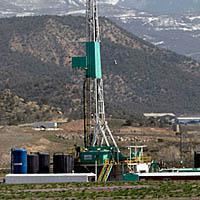 As we have discussed in a number of articles, natural gas production in the U.S. is expanding rapidly. For the most part, this is due to the discovery of hydraulic fracturing, or “fracking,” which frees natural gas from shale rock formations. Today, shale gas comprises 25 percent of all natural gas production (up from 1 percent in 2000), thus reducing the price of natural gas by half in the last three years.
As we have discussed in a number of articles, natural gas production in the U.S. is expanding rapidly. For the most part, this is due to the discovery of hydraulic fracturing, or “fracking,” which frees natural gas from shale rock formations. Today, shale gas comprises 25 percent of all natural gas production (up from 1 percent in 2000), thus reducing the price of natural gas by half in the last three years.
In terms of carbon emissions, traditionally-derived natural gas is less pollutive than other forms of fossil fuels. The Union of Concerned Scientists reports that natural gas produces 43 percent and 30 percent fewer emissions per unit of energy compared to coal and oil, respectively. This is very good news considering it is estimated that 2,500 trillion cubic feet of natural gas are located in the U.S. and Canada – thought to be equal to a one-hundred year energy supply at current consumption rates.
However, a report by the Climatic Change Journal found that carbon emissions from shale gas are at least 30 percent to two times as great as those associated with traditional gas. According to the study, “the higher emissions from shale gas occur at the time wells are hydraulically fractured – as methane escapes from flow-back return fluids – and during drill out following the fracturing.” The report estimates that 3.6 to 7.9 percent of methane escapes during these processes.
As methane is a more potent greenhouse gas than CO2, yet remains in the atmosphere for a shorter period, its comparative warming effect changes with time. Over twenty years, the greenhouse effect of shale gas is far greater than that produced by the carbon dioxide of coal and oil. Over one-hundred years, however, this disparity is reduced, making it roughly equal to coal, and closer in effect – but still greater – than oil.
With 20,000 shale wells drilled in the last decade, methane leaks associated with fracking must be regulated and/or reduced. Environmentalists also are concerned that more drilling will exacerbate current worries including water consumption, water pollution, and the as yet undeclared mixture of chemicals used during the fracturing process. Debates on these issues will continue, but since many of them directly impact the bottom line, we can (probably) expect reasonable efficiencies to be made in the coming years.
Image

